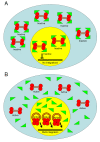Peptides derived from the HIV-1 integrase promote HIV-1 infection and multi-integration of viral cDNA in LEDGF/p75-knockdown cells
- PMID: 20678206
- PMCID: PMC2924314
- DOI: 10.1186/1743-422X-7-177
Peptides derived from the HIV-1 integrase promote HIV-1 infection and multi-integration of viral cDNA in LEDGF/p75-knockdown cells
Abstract
Background: The presence of the cellular Lens Epithelium Derived Growth Factor p75 (LEDGF/p75) protein is essential for integration of the Human immunodeficiency virus type 1 (HIV-1) cDNA and for efficient virus production. In the absence of LEDGF/p75 very little integration and virus production can be detected, as was demonstrated using LEDGF/p75-knockdown cells.
Results: Here we show that the failure to infect LEDGF/p75-knockdown cells has another reason aside from the lack of LEDGF/p75. It is also due to inhibition of the viral integrase (IN) enzymatic activity by an early expressed viral Rev protein. The formation of an inhibitory Rev-IN complex in virus-infected cells can be disrupted by the addition of three IN-derived, cell-permeable peptides, designated INr (IN derived-Rev interacting peptides) and INS (IN derived-integrase stimulatory peptide). The results of the present work confirm previous results showing that HIV-1 fails to infect LEDGF/p75-knockdown cells. However, in the presence of INrs and INS peptides, relatively high levels of viral cDNA integration as well as productive virus infection were obtained following infection by a wild type (WT) HIV-1 of LEDGF/p75-knockdown cells.
Conclusions: It appears that the lack of integration observed in HIV-1 infected LEDGF/p75-knockdown cells is due mainly to the inhibitory effect of Rev following the formation of a Rev-IN complex. Disruption of this inhibitory complex leads to productive infection in those cells.
Figures






Similar articles
-
Integration of HIV-1 DNA is regulated by interplay between viral rev and cellular LEDGF/p75 proteins.Mol Med. 2010 Jan-Feb;16(1-2):34-44. doi: 10.2119/molmed.2009.00133. Epub 2009 Oct 29. Mol Med. 2010. PMID: 19855849 Free PMC article.
-
Transient and stable knockdown of the integrase cofactor LEDGF/p75 reveals its role in the replication cycle of human immunodeficiency virus.J Virol. 2006 Feb;80(4):1886-96. doi: 10.1128/JVI.80.4.1886-1896.2006. J Virol. 2006. PMID: 16439544 Free PMC article.
-
Characterization of the HIV-1 integrase chromatin- and LEDGF/p75-binding abilities by mutagenic analysis within the catalytic core domain of integrase.Virol J. 2010 Mar 23;7:68. doi: 10.1186/1743-422X-7-68. Virol J. 2010. PMID: 20331877 Free PMC article.
-
Host factors for retroviral integration site selection.Trends Biochem Sci. 2015 Feb;40(2):108-16. doi: 10.1016/j.tibs.2014.12.001. Epub 2014 Dec 31. Trends Biochem Sci. 2015. PMID: 25555456 Review.
-
The human immunodeficiency virus type 1 Rev protein: ménage à trois during the early phase of the lentiviral replication cycle.J Gen Virol. 2010 Aug;91(Pt 8):1893-1897. doi: 10.1099/vir.0.022509-0. Epub 2010 Jun 9. J Gen Virol. 2010. PMID: 20538907 Review.
Cited by
-
Nup153 Unlocks the Nuclear Pore Complex for HIV-1 Nuclear Translocation in Nondividing Cells.J Virol. 2018 Sep 12;92(19):e00648-18. doi: 10.1128/JVI.00648-18. Print 2018 Oct 1. J Virol. 2018. PMID: 29997211 Free PMC article.
References
-
- Emiliani S, Mousnier A, Busschots K, Maroun M, Van Maele B, Tempe D, Vandekerckhove L, Moisant F, Ben-Slama L, Witvrouw M. Integrase mutants defective for interaction with LEDGF/p75 are impaired in chromosome tethering and HIV-1 replication. J Biol Chem. 2005;280:25517–25523. doi: 10.1074/jbc.M501378200. - DOI - PubMed
Publication types
MeSH terms
Substances
LinkOut - more resources
Full Text Sources
Research Materials

